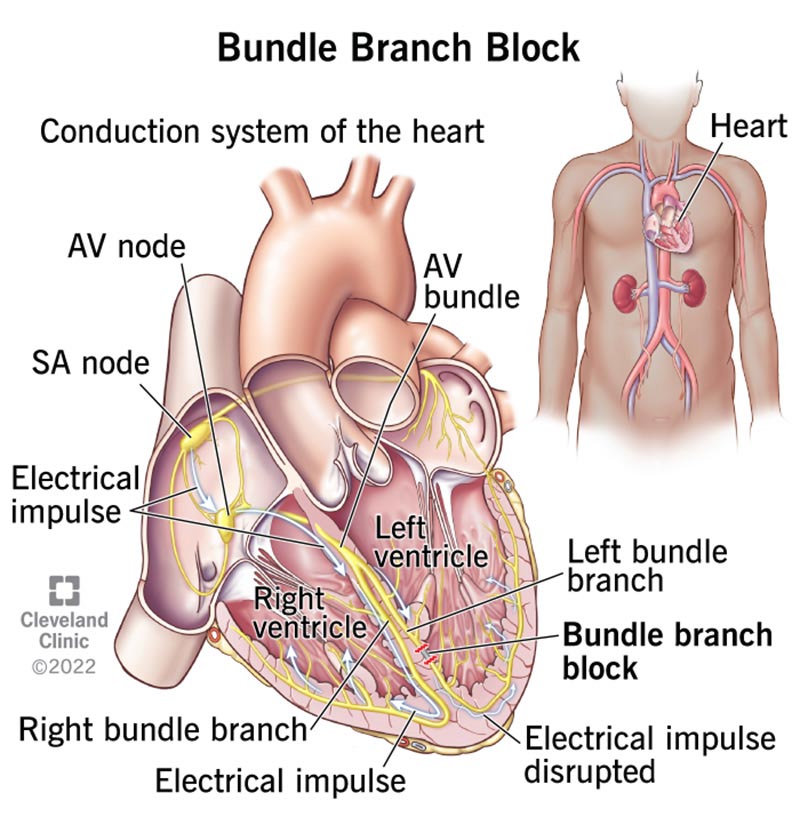Bundle branch block (BBB) is a block or disruption to the electrical impulse that contracts your heart’s lower chambers. BBB causes an irregular heartbeat. BBB often has no symptoms. Many people don’t need treatment unless they have underlying heart conditions. Treatments include medications for other health issues or insertion of a pacemaker.
Advertisement
Cleveland Clinic is a non-profit academic medical center. Advertising on our site helps support our mission. We do not endorse non-Cleveland Clinic products or services. Policy

A bundle branch block (BBB) is when something blocks or disrupts the electrical signal that causes your heart to beat. This block leads to an abnormal heart rhythm.
Advertisement
Cleveland Clinic is a non-profit academic medical center. Advertising on our site helps support our mission. We do not endorse non-Cleveland Clinic products or services. Policy
Your heart’s tissue sends electrical impulses that travel through pathways called bundle branches. These impulses normally travel through the bottom chambers of your heart (ventricles). Your heart’s two ventricles usually contract at the same time. But a bundle branch block delays the electrical signal, therefore, the ventricle that receives the delayed signal will contract at a later time.
Healthcare providers don’t always treat bundle branch blocks. But they may treat the underlying health problems that cause the block.
There are two types of bundle branch blocks:
You can have a disruption in one bundle or in both your left bundle and your right bundle at the same time.
Anyone can have a bundle branch block. The risk of both right bundle branch block and left bundle branch block increases with age and other health conditions, such as heart disease.
Advertisement
Bundle branches form part of your heart conduction system, which controls your heartbeat. A block affects your body based on where it’s located:
Conditions that can cause a bundle branch block include:
Right bundle branch block may also result from lung diseases including:
Sometimes, a bundle branch block has no known cause. It can happen in people whose hearts otherwise function normally and who have no underlying conditions.
A bundle branch block may not cause any symptoms. When this condition does cause symptoms, they may include:
Bundle branch blockages on both sides may cause symptoms including:
You’re more likely to feel symptoms if you have:
Healthcare providers diagnose BBB with two main tests:
Advertisement
If your provider diagnoses you with BBB, they will check you for related health conditions. They may recommend the following tests:
If you don’t have symptoms or underlying conditions, you may not need treatment for bundle branch block. You may need medication to control other issues such as high blood pressure or heart failure symptoms.
If you have symptoms such as fainting, your provider may suggest a pacemaker. A cardiac electrophysiologist (a subspecialized cardiologist, specifically trained to manage abnormal heart rhythms) places this device under the skin of your chest. Wires connected to your heart help it beat at a steady rate.
If you have heart failure or dilated cardiomyopathy, your provider may recommend cardiac resynchronization therapy (CRT) using a biventricular pacemaker. This type of pacemaker helps both of your ventricles contract at the same time. CRT can help lessen symptoms such as shortness of breath.
Advertisement
You will have a bundle branch block for the rest of your life. The block may either stay the same or worsen over time.
A left bundle branch block may be the first sign of a complete heart block. So, the U.S. and U.K. restrict pilots with LBBB from flying an airplane. Otherwise, having a bundle branch block usually won’t affect your work, unless you have severe symptoms.
If you have no underlying conditions, bundle branch block may not affect your overall health or life span. If you have other conditions that affect your heart, BBB may make your heart deteriorate faster and worsen your symptoms.
You can lower your risk of BBB and other heart problems by staying healthy and making smart choices. These include:
You’re at higher risk of death if you have a bundle branch block along with:
Chest pain along with a new left bundle branch block may indicate a serious underlying health condition, such as a heart attack.
Advertisement
If you see a new healthcare provider, always tell them that you have a bundle branch block. This information will help them better monitor your heart health and overall wellness.
Make sure your provider knows about your BBB diagnosis if you have:
You may want to carry a copy of your EKG, so you have it handy if an emergency happens.
See your provider if you have any new symptoms or your symptoms get worse. Seek medical treatment immediately if you have:
A bundle branch block (BBB) is a blockage or disruption to the electrical signal that causes your heart to beat. BBB can affect your right ventricle (right bundle branch block), left ventricle (left bundle branch block) or both ventricles. Many times, bundle branch blocks don’t cause any symptoms, though they sometimes lead to dizziness or fainting. Providers usually diagnose BBB with an EKG or echocardiogram. You may not need treatment for BBB, though you’ll need to treat any underlying conditions. Most people with a bundle branch block can lead full lives, though their risk of death may increase if they have other heart problems.
When your heart rhythm is out of sync, the experts at Cleveland Clinic can find out why. We offer personalized care for all types of arrhythmias.

Last reviewed on 05/05/2022.
Learn more about the Health Library and our editorial process.